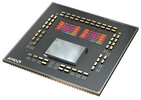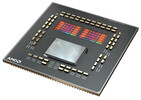AMD Ryzen 9 5900HS vs AMD Ryzen 7 5800X vs AMD Ryzen 9 5950X
AMD Ryzen 9 5900HS
► remove from comparison
The AMD Ryzen 9 5900HS is a processor for big (gaming) laptops based on the Cezanne generation. The R9 5900HS integrates all eight cores based on the Zen 3 microarchitecture. They are clocked at 3 GHz (guaranteed base clock) to 4.6 GHz (Turbo) and support SMT / Hyperthreading (16 threads). The chip is manufactured on the modern 7 nm TSMC process. Compared to the 5900HX (up to 54 W), the 5900HS is configured with a TDP of 35 W.
The new Zen 3 microarchitecture offers a significantly higher IPC (instructions per clock) compared to Zen 2. For desktop processors AMD claims 19 percent on average and in applications reviews showed around 12% gains at the same clock speed.
In addition to the eight CPU cores, the APU also integrates a Radeon RX Vega 8 iGPU with 8 CUs at up to 2100 MHz. The dual channel memory controller supports DDR4-3200 and energy efficient LPDDR4-4266 RAM. Furthermore, 16 MB of Level 3 cache can be found on the chip.
Performance
The average 5900HS in our database matches the Core i7-12650H, the Core i9-11900H and the Core i9-11980HK in multi-thread performance. Surprisingly enough, it manages to come unbelievably close to the more power-hungry Ryzen 9 5900HX. This is a great CPU in all respects, and laptop makers as well as mini-PC manufacturers are taking notice.
Thanks to its decent cooling solution and a long-term CPU power limit of 80 W, the Zephyrus G14 GA401QEC is among the fastest laptops powered by the 5900HS that we know of. It can be at least 10% faster in CPU-bound workloads than the slowest system featuring the same chip in our database, as of August 2023.
Power consumption
This Ryzen 9 series chip has a default TDP (also known as the long-term power limit) of 35 W that laptop makers aren't really required to stick to. Either way, an active cooling solution is a must for a CPU like this.
The Ryzen 9 5900HS is built with TSMC's 7 nm process for average, as of mid 2023, energy efficiency.
AMD Ryzen 7 5800X
► remove from comparison
The AMD Ryzen 7 5800X is an 8-core desktop processor with Simultaneous Multithreading (SMT), which allows it to process 16 threads simultaneously. With its launch on 08.10.2020, it is the fastest 8-core processor from AMD. The second fastest 8-core processor will be the AMD Ryzen 7 3800XT, followed by the more economical AMD Ryzen 7 3700X, also with 8 cores and 16 threads.
The Ryzen 7 5800X clocks with a base clock of 3.8 GHz and reaches up to 4.7 GHz on one core in turbo mode. When all 8 cores are utilized, the AMD Ryzen 7 5800X, like the AMD Ryzen 9 5900X, achieves up to 4.5 GHz.
At first glance, the internal structure of the processor has not changed fundamentally. The CCX structure has changed somewhat compared to Zen2, because now a CCX consists of up to 8-CPU cores. So each individual core can access the complete L3 cache (32 MByte). Furthermore the CCX modules are connected to each other via the same I/O die, which we already know from Zen2. According to AMD, the Infinity-Fabric should now reach clock rates of up to 2Ghz, which in turn allows a RAM clock of 4.000 MHz without performance loss.
Performance
The average 5800X in our database is in the same league as the Core i9-10900K and also the Core i7-12700F, as far as multi-thread benchmark scores are concerned.
In games, AMD's Ryzen 7 5800X can convince with its significantly improved IPC and even put Intel in its place. With the AMD Ryzen 7 5800X, gamers are well prepared for the future as simultaneous streaming is no problem with the new Ryzen 7 5800X. Semi-professional content creators, who need even more power, can choose a Ryzen 9 5900X or the Ryzen 9 5950X on the shelf.
Power consumption
The Ryzen 7 has a default TDP (also known as the long-term power limit) of 105 W. This applies as long as the CPU runs at stock clock speeds.
Ryzen 7 5800X is built with TSMC's 7 nm process; as rumors have it, the I/O die is manufactured separately on the 12 nm Global Foundries process.
AMD Ryzen 9 5950X
► remove from comparison
The AMD Ryzen 9 5950X is a high-end 16-core, hyperthreaded (SMT) Vermeer Series desktop processor. With 32 threads, the new flagship offers as many threads as the AMD Ryzen 9 3950X. Introduced on October 8, 2020, the Ryzen 9 5950X is the fastest 16-core processor and is specified at 105 watts TDP.
The Ryzen 9 5950X runs at 3.4 GHz to 4.9 GHz (single core). Wen all 16 cores are loaded, up to 4.5 GHz are still possible.
The internal structure of the processor has not changed fundamentally at first glance. The CCX structure has changed a bit compared to Zen 2, because now a CCX consists of up to 8 CPU cores. So each individual core can access the complete L3 cache (32 MByte). Furthermore the CCX modules are connected to each other via the same I/O die, which we already know from Zen2. According to AMD, the Infinity fabric should now reach clock rates of up to 2 Ghz, which in turn allows a RAM clock of 4,000 MHz without performance loss.
Performance
The average 5950X in our database matches the Core i9-12900K, the Core i9-12900HX and also the Ryzen Threadripper 2970WX in multi-thread performance, making this Ryzen a great processor for pretty much any task imaginable as of mid 2022.
Power consumption
This Ryzen 9 series chip has a default TDP (also known as the long-term power limit) of 105 W. It will, however, happily consume much more than that as long as the cooling solution is able to handle the heat - even before one starts considering the possibility of overclocking the thing.
The Ryzen 9 5950X is built with TSMC's 7 nm process for average, as of mid 2023, energy efficiency.
| Model | AMD Ryzen 9 5900HS | AMD Ryzen 7 5800X | AMD Ryzen 9 5950X | ||||||||||||||||||||||||||||||||||||||||||||||||
| Codename | Cezanne-HS (Zen 3) | Vermeer (Zen 3) | Vermeer (Zen 3) | ||||||||||||||||||||||||||||||||||||||||||||||||
| Series | AMD Cezanne (Zen 3, Ryzen 5000) | AMD Vermeer (Ryzen 5000) | AMD Vermeer (Ryzen 5000) | ||||||||||||||||||||||||||||||||||||||||||||||||
| Series: Vermeer (Ryzen 5000) Vermeer (Zen 3) |
|
|
| ||||||||||||||||||||||||||||||||||||||||||||||||
| Clock | 3000 - 4600 MHz | 3800 - 4700 MHz | 3400 - 4900 MHz | ||||||||||||||||||||||||||||||||||||||||||||||||
| L1 Cache | 512 KB | 512 KB | 1 MB | ||||||||||||||||||||||||||||||||||||||||||||||||
| L2 Cache | 4 MB | 4 MB | 8 MB | ||||||||||||||||||||||||||||||||||||||||||||||||
| L3 Cache | 16 MB | 32 MB | 64 MB | ||||||||||||||||||||||||||||||||||||||||||||||||
| Cores / Threads | 8 / 16 | 8 / 16 | 16 / 32 | ||||||||||||||||||||||||||||||||||||||||||||||||
| TDP | 35 Watt | 105 Watt | 105 Watt | ||||||||||||||||||||||||||||||||||||||||||||||||
| Technology | 7 nm | 7 nm | 7 nm | ||||||||||||||||||||||||||||||||||||||||||||||||
| Socket | FP6 | AM4 (LGA1331) | AM4 | ||||||||||||||||||||||||||||||||||||||||||||||||
| Features | DDR4-3200/LPDDR4-4266 RAM, PCIe 3, MMX, SSE, SSE2, SSE3, SSSE3, SSE4A, SSE4.1, SSE4.2, AVX, AVX2, BMI2, ABM, FMA, ADX, SMEP, SMAP, SMT, CPB, AES-NI, RDRAND, RDSEED, SHA, SME | DDR4-3200 RAM, PCIe 4, MMX (+), SSE, SSE2, SSE3, SSSE3, SSE4.1, SSE4.2, SSE4A, AES, AVX, AVX2, FMA3, SHA | DDR4-3200 RAM, PCIe 4, MMX (+), SSE, SSE2, SSE3, SSSE3, SSE4.1, SSE4.2, SSE4A, AES, AVX, AVX2, FMA3, SHA | ||||||||||||||||||||||||||||||||||||||||||||||||
| iGPU | AMD Radeon RX Vega 8 (Ryzen 4000/5000) ( - 2100 MHz) | ||||||||||||||||||||||||||||||||||||||||||||||||||
| Architecture | x86 | x86 | x86 | ||||||||||||||||||||||||||||||||||||||||||||||||
| Announced | |||||||||||||||||||||||||||||||||||||||||||||||||||
| Manufacturer | www.amd.com | www.amd.com | www.amd.com | ||||||||||||||||||||||||||||||||||||||||||||||||
| Die Size | 2 x 80.7 sq. mm; I/O = 125 mm2 | CPU cores: 2x 80.7 sq. mm., I/O: 125 mm2 | |||||||||||||||||||||||||||||||||||||||||||||||||
| max. Temp. | 90 °C | ||||||||||||||||||||||||||||||||||||||||||||||||||
| $449 U.S. | $799 U.S. |
Benchmarks
Average Benchmarks AMD Ryzen 9 5900HS → 100% n=33
Average Benchmarks AMD Ryzen 7 5800X → 120% n=33
Average Benchmarks AMD Ryzen 9 5950X → 144% n=33
* Smaller numbers mean a higher performance
1 This benchmark is not used for the average calculation












